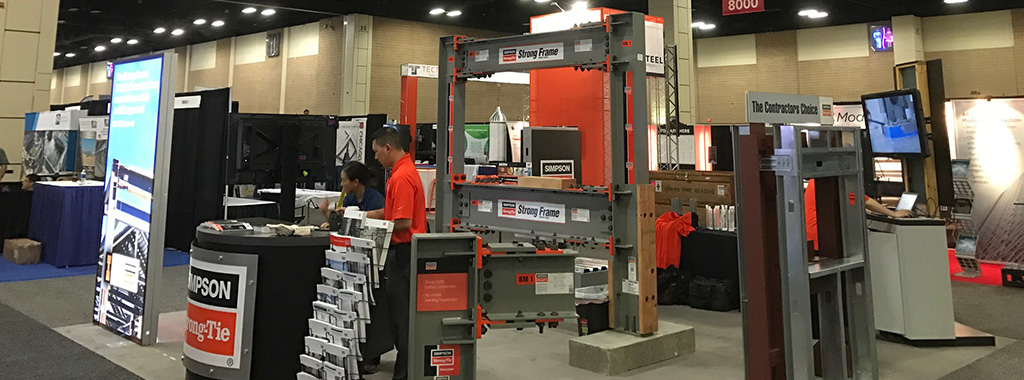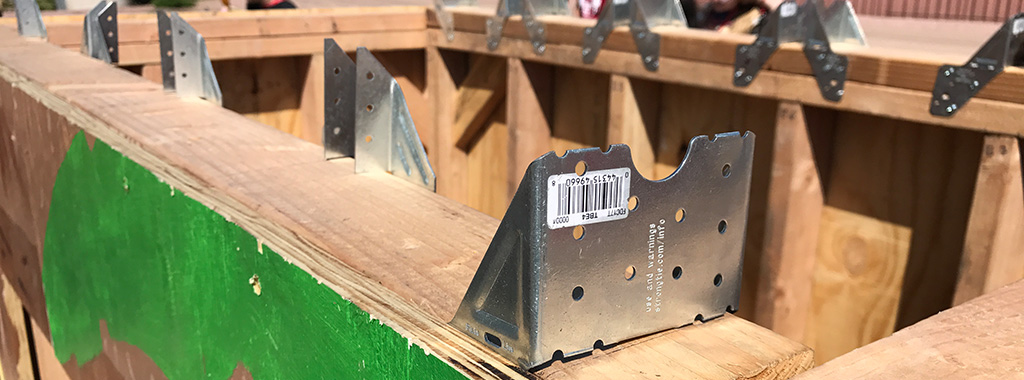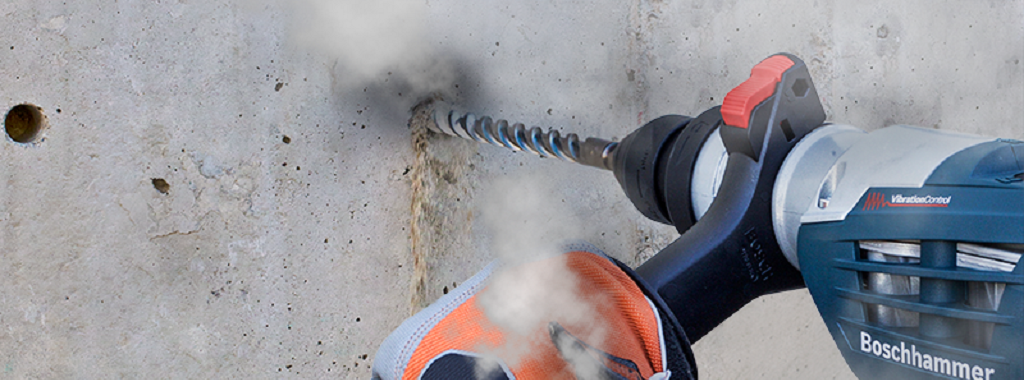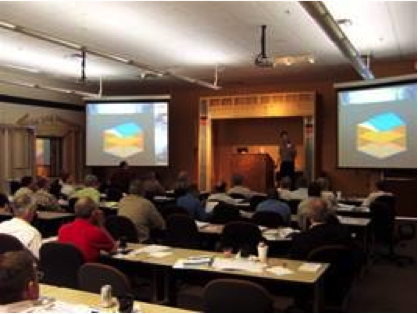Structural engineers mostly take rightful pride in their skills and the importance of what they do. In other respects, however, job satisfaction can be uneven within the field, without much opportunity for engineers to address questions of professional engagement, mentorship, compensation or equity. The Structural Engineering, Engagement, and Equity (SE3) survey, sponsored by NCSEA, is an attempt to remedy this shortcoming. In the following post, Annie Kao, a structural engineer with Simpson Strong-Tie, gives an overview of this development.
Continue Reading
Category: Academia
Our academia posts are dedicated to helping our customers and the general public acquire a deeper understanding of solutions and how they relate to the industry.
NASCC 2018: Debuting Our Newest Yield Link Connection
This year the NASCC (North American Steel Construction Conference) will be in Baltimore, Maryland. The conference is the annual educational and networking event for the structural steel industry, which attracts attendees and exhibitors from all over the world. With more than 130 sessions this year, the conference will provide attendees the opportunity to learn the latest in research, design, technology and best practice in the steel industry.
Continue Reading
Timber Strong Gives Engineering Students Real-World Experience
Structural engineering, like every other research field, advances by educating new generations of students in the principles and practice of the discipline. Knowing that, Simpson Strong-Tie has teamed with the Binational Softwood Lumber Council and the American Wood Council to co-sponsor and coordinate the Timber Strong Design-Build Competition, an annual design contest held at the ASCE Pacific Southwest Conference in Tempe, Arizona.
Engineering students will test their civil and environmental engineering skills this spring when they compete in the annual Timber Strong Design-Build Competition. Eighteen universities will send teams of students to Tempe, Arizona, to participate at the American Society of Civil Engineers (ASCE) Pacific Southwest Conference (PSWC).
The objective of the competition, taking place April 12–14, is to give students valuable real-world engineering design experience:
Continue Reading
My Engineering Adventures with Build Change
This week’s post was written by James P. Mwangi, Ph.D., P.E., S.E. – our first annual Simpson Strong-Tie Engineering Excellence Fellow with Build Change.
Let me start by wishing everyone a happy holiday season.
My fellowship activities started in July 2017. I spent two weeks in New Jersey getting oriented to the Build Change organization and engineering activities around the world. I then spent two days in Pleasanton getting to meet the engineering team and getting updated on Simpson Strong-Tie products and the team leaders.
Continue Reading
What You Need to Know About Differences in Wind-Speed Reporting for Hurricanes
There is a great deal of good information out there to help us better understand hurricanes and their impact on people, structures and other property. To improve awareness of wind speeds and their measurement, this article will discuss a commonly misunderstood aspect of hurricane wind-speed reporting.
Continue Reading
What Structural Engineers Need to Know About the New OSHA Silica Dust Standards
In March of 2016, the United States Department of Labor issued new OSHA standards on how crystalline silica dust should be handled in various workplaces including within the construction industry. The changes are intended to limit workers’ exposure to and inhalation of silica dust on the jobsite. These regulations will replace the current standard, which was issued in 1971. Compliance with the new rules will be required on construction jobsites starting September 23, 2017, and will be enforced through OSHA from that time forward.
Continue Reading
Meet the First Simpson Strong-Tie Engineering Excellence Fellow with Build Change
Introducing James P. Mwangi, Ph.D., P.E., S.E. – our first annual Simpson Strong-Tie Engineering Excellence Fellow with Build Change. James Mwangi will write a quarterly blog about his experience throughout the Fellowship.
I’m delighted to have been asked to contribute this post and feel honored to be the first-ever Simpson Strong-Tie Engineering Excellence Fellow with Build Change. It’s my hope that this post will inform you about my professional background, why I applied to the Fellowship and how I think the Fellowship can benefit people and the structures they live, work and go to school in.
Continue Reading
What Makes a Good Training Facility?
When it comes to choosing a training facility, there are many well-researched principles about what makes an environment conducive to improved adult learning.
While we try to hold all training events in facilities that meet most of these principles, (even when traveling to our customers or users means we have to conduct events in hotel meeting rooms) we prefer to host you at our own locations.
To this end, we invest a tremendous amount of time and resources to build and offer dedicated training facilities across the country. These facilities meet all the basic requirements for improved adult learning, but much more as well.
By having our own dedicated training facilities, we can provide learners with a much richer experience and contextually relevant displays.
These displays include partially deconstructed wall segments, foundations and roof systems that give learners a bigger picture of the applications being studied.
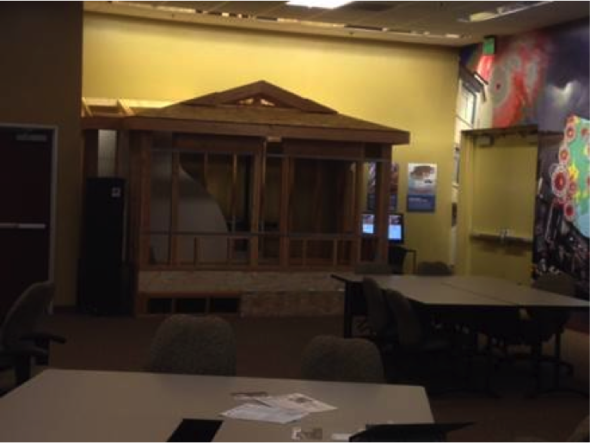 Many displays allow for hands-on installations and exercises that allow for improved comprehension of the product use and limitations. Even for the engineering community, who typically are limited to images from a catalog, the hands-on activities add great value. It’s always interesting to see the reaction that engineers have to actually seeing a system approach and having an opportunity to participate in learning that goes way beyond sitting and listening to a lecture.
Many displays allow for hands-on installations and exercises that allow for improved comprehension of the product use and limitations. Even for the engineering community, who typically are limited to images from a catalog, the hands-on activities add great value. It’s always interesting to see the reaction that engineers have to actually seeing a system approach and having an opportunity to participate in learning that goes way beyond sitting and listening to a lecture.
Sometimes learners just need to see, feel or hold something in order to really understand a concept or product application. We make every effort to bring legitimate educational content to our workshops, supported by products that we hope will furnish solutions to your needs.
Many of our facilities include a plant tour and/or testing-facility tour as well. While these components don’t always align directly with the learning objectives, they do offer a chance for our guests to raise their energy levels and get a better understanding of that scale, capabilities, and commitment to quality that we bring to bear in our endeavor to help people build safer structures.
Additionally, we offer our facilities to customers, associations and industry organizations to use for their own meetings and training events. If you haven’t been to one of our workshops or visited one of our facilities, I highly encourage you to join the 35,000 plus who have over the last four years. You can find a complete list of workshops on our training home page. I expect that you’ll find it an educational and highly engaging experience that helps you build safer structures as well.

3 Hot Tips for Structural Engineers Who Want to Earn Education Credits and Stay Sharp
Do you ever get so busy that you can’t keep up with the structural engineer training opportunities that are available? We have previously shared online resources and webinars that are available to structural engineers, but did you know that you can take advantage of Simpson Strong-Tie regional training centers that offer complimentary workshops and classes about proper specification, product installation and inspection of connectors and structural systems? Here are some tips on staying current with your training.
Simpson Strong-Tie training courses and webinars are focused on improving building standards and the overall safety of structures. With eight training centers across North America, Simpson Strong-Tie provides hundreds of complimentary classes to engineers, architects, builders and code officials each year. In fact, we have trained more than 24,000 participants online and in-person in 2016 alone.
“The workshops are very interactive,” explained Charlie Roesset, Director of Training for Simpson Strong-Tie. “Depending on the course, students may have the opportunity to view product samples or take part in product testing and installations.”
Tip #1 Make Training Offerings Work for You
 If you specialize in a specific discipline, look for courses that are targeted to your area of interest or expertise. Simpson Strong-Tie courses include a broad range of topics from anchor system installation and engineered wood frame construction to seismic and high-wind design. We also incorporate the latest building-code updates and industry trends into our training curriculum. No matter where you are in your professional career, we offer a course that’s right for you. There are introductory courses as well as more advanced workshops for repeat and seasoned attendees.
If you specialize in a specific discipline, look for courses that are targeted to your area of interest or expertise. Simpson Strong-Tie courses include a broad range of topics from anchor system installation and engineered wood frame construction to seismic and high-wind design. We also incorporate the latest building-code updates and industry trends into our training curriculum. No matter where you are in your professional career, we offer a course that’s right for you. There are introductory courses as well as more advanced workshops for repeat and seasoned attendees.
Training participants receive a certificate of attendance with professional development hours (PDHs) at the end of each workshop, and may earn continuing education units (CEUs) and/or learning units (LUs) by completing additional requirements. Simpson Strong-Tie is a registered education provider with a number of industry organizations and associations including CSI, BIA, ACIA, AIBD, ICC, AIA* and IACET**.
Tip #2 Find Trainings That Are Current
Do your research to find workshops and online courses that are regularly updated to reflect changes within the industry. For example, we have regular trainings that focus on the new seismic retrofit ordinances in various municipalities on the West Coast (such as Los Angeles’ Soft-Story Retrofit Ordinance) and others on high-wind design and construction in the Southeast. Our trainings are tailored to your design needs based on your practice’s location.
Full-day workshops typically run from 8:00 a.m. to 4:00 p.m. Classes are often tailored toward specific audiences types to ensure that the training is appropriate and effective. Many courses are team-taught by registered engineers to provide in-depth technical expertise in the subject matter. While much of the instruction is technical in nature, many real-life examples and hands-on demonstrations are provided to help all attendees fully understand the material presented.
Tip #3 Hear What Other Structural Engineers Have to Say
It is always a good sign when others in your field have good things to say about the courses they have taken. Below are some comments past participants have said about our training offerings:
Fred B., S.E., an engineer from Las Vegas, NV, has been a regular attendee of Simpson Strong-Tie workshops. He says the training keeps him informed of topics relevant to his industry and is a great way to keep up with his professional development hours. “Some of the courses offered by other groups are just not that interesting and they can be quite expensive. Simpson programs are interesting, hands-on and free. It’s the whole package.”
Bob N., an engineer from Richmond, VA, wrote, “Keep up the good work; I have found your seminars to be well done, pertinent, and useful. We also specify a lot of your products because of the training and the fact that you have an excellent product line.”
Kathy P., an engineer from Somerville, TX, shares: “You guys are so great! You teach well and keep it interesting. . . . . You support the industry to the benefit of everyone, not just your bottom line, and you make educational credits cost effective. Thank you, thank you, thank you!”
Sign up for a workshop and find out more about Simpson Strong-Tie training programs, including our latest online courses, by visiting www.strongtie.com/workshops.
* Simpson Strong-Tie is registered with the American Institute of Architects, Continuing Education System (AIA CES) as a provider of AIA Learning Units (AIA LUs).
** Simpson Strong-Tie is accredited by the International Association for Continuing Education and Training (IACET) and is authorized to issue the IACET CEU.
Written by Minara El-Rahman in collaboration with the Simpson Strong-Tie Training Department.
Use Strong-Wall® Shearwall Selector to Design Shearwalls
In time for spring and summer 2017 construction projects, Simpson Strong-Tie has launched the newest version of the Strong-Wall Shearwall Selector for use with engineered design. The latest release is an easy-to-use Web-based application (that’s right, no software to download) that has been updated to comply with the 2015 IBC and now provides solutions for all three Strong-Wall Shearwall types: the Steel Strong-Wall® shearwall (SSW), the Strong-Wall wood shearwall (WSW) and the wood Strong-wall shearwall (SW). If you are familiar with the Strong-Wall Shearwall Selector, you can begin using the web application immediately. For those of you who would like to know more about the web app, please read on.Continue Reading


